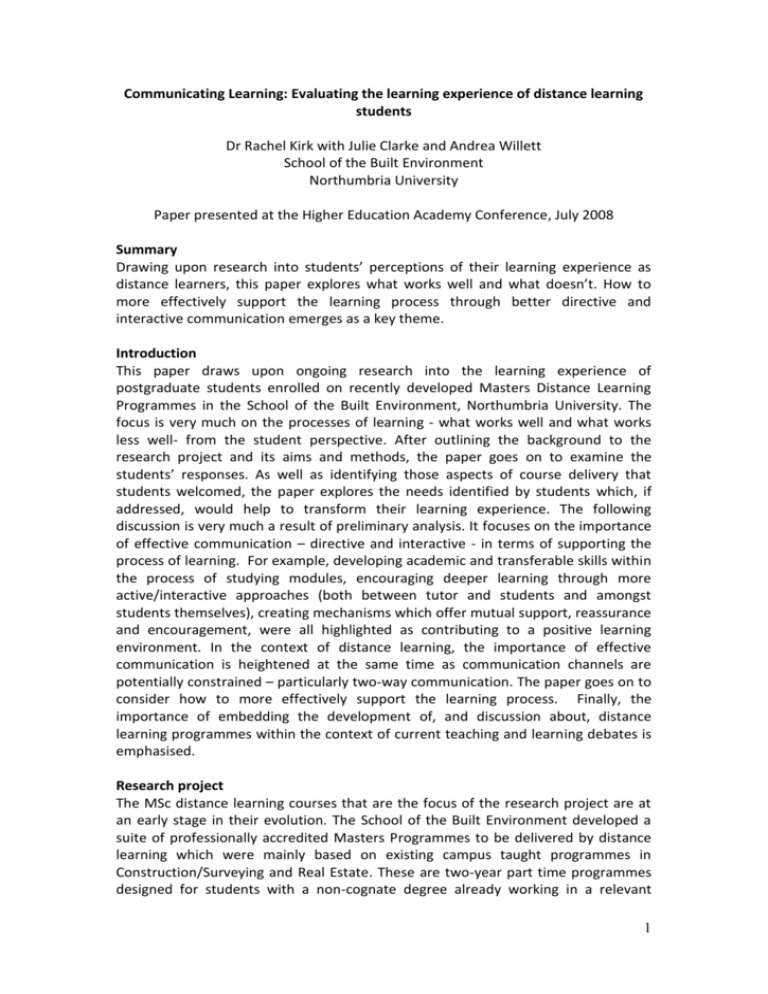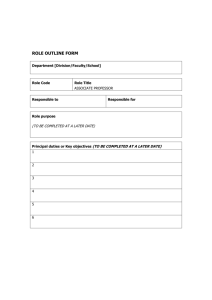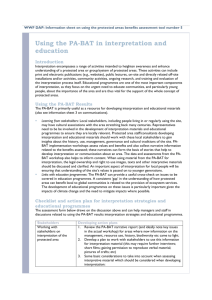Communicating Learning: Evaluating the learning experience of
advertisement

Communicating Learning: Evaluating the learning experience of distance learning students Dr Rachel Kirk with Julie Clarke and Andrea Willett School of the Built Environment Northumbria University Paper presented at the Higher Education Academy Conference, July 2008 Summary Drawing upon research into students’ perceptions of their learning experience as distance learners, this paper explores what works well and what doesn’t. How to more effectively support the learning process through better directive and interactive communication emerges as a key theme. Introduction This paper draws upon ongoing research into the learning experience of postgraduate students enrolled on recently developed Masters Distance Learning Programmes in the School of the Built Environment, Northumbria University. The focus is very much on the processes of learning - what works well and what works less well- from the student perspective. After outlining the background to the research project and its aims and methods, the paper goes on to examine the students’ responses. As well as identifying those aspects of course delivery that students welcomed, the paper explores the needs identified by students which, if addressed, would help to transform their learning experience. The following discussion is very much a result of preliminary analysis. It focuses on the importance of effective communication – directive and interactive - in terms of supporting the process of learning. For example, developing academic and transferable skills within the process of studying modules, encouraging deeper learning through more active/interactive approaches (both between tutor and students and amongst students themselves), creating mechanisms which offer mutual support, reassurance and encouragement, were all highlighted as contributing to a positive learning environment. In the context of distance learning, the importance of effective communication is heightened at the same time as communication channels are potentially constrained – particularly two-way communication. The paper goes on to consider how to more effectively support the learning process. Finally, the importance of embedding the development of, and discussion about, distance learning programmes within the context of current teaching and learning debates is emphasised. Research project The MSc distance learning courses that are the focus of the research project are at an early stage in their evolution. The School of the Built Environment developed a suite of professionally accredited Masters Programmes to be delivered by distance learning which were mainly based on existing campus taught programmes in Construction/Surveying and Real Estate. These are two-year part time programmes designed for students with a non-cognate degree already working in a relevant 1 professional environment. Initially the modules were mostly made up of a number of papers prepared by staff, typically incorporating text, tasks, self assessment, additional directed reading and use of asynchronous communication through Discussion Boards. The papers were made available to students via the University’s eLearning portal (Blackboard). In addition, students were invited to attend a seminar held at the university each semester. The research project is supported by the School of the Built Environment through a small research grant, recognising the importance of obtaining, understanding and acting upon student feedback in terms of developing courses in a student centred way. The project is being conducted by a small team of researchers (some of whom are involved in the delivery of the distance learning programmes) and is due to be completed by September 2008. The aim is to evaluate the learning experience from the student perspective. The project aims to explore students’ views on what works well – and less well – in terms of supporting learning effectively, and to inform the ongoing evolution of the courses. The first and second cohorts of students to study the courses are the participants in this research. An initial feedback exercise was conducted with 38 students (two thirds of the total) who were attending one of the supporting seminars at the university. Students responded to general questions about their overall learning experience, what aspects they found to be effective and what aspects were less successful in their opinion, and what, if anything, they felt was missing. Such views were to inform the issues to be followed up further in the research. On the basis of this initial consultation an individual questionnaire was developed and was carried out electronically, with a response rate of approximately 50%. Subsequently, focus groups were conducted to explore selected issues in a qualitative, in-depth way. Again, given time and resource constraints, these focus groups were carried out at the university with students attending the second bi-annual support seminar. It must be acknowledged that all data was anonymous so it is not known to what extent different respondents participated in the different feedback mechanisms. For example, it may be that those who study from a considerable distance are perhaps less likely to attend the university seminars and more likely to respond to the esurvey. Additionally, it is intended that interviews will be conducted with key managerial and administrative staff associated with the distance delivery programmes. These are currently underway as the research is still very much work in progress. This paper presents an opportunity to explore the emerging issues from the student data and help inform the ongoing analysis. The students’ views The initial feedback exercise identified many aspects of their experience that students were highly satisfied with, including on-line facilities and feature of teaching materials such as drop down answers. Other aspects of teaching materials were seen as problematic, for example, lengthy text to read within papers with no supporting tasks. A number of students called for greater diversity within teaching 2 materials. There were split views about Discussion Boards – some strongly disliking them and others identifying them as particularly useful. Lack of/slow/poor feedback emerged as one of students’ major concerns, while the two day seminar attendance at the university was overwhelmingly one of the most positive aspects identified by students. The survey (29 respondents) demonstrated a considerable level of satisfaction. For example, approximately half of respondents were satisfied with the preparation offered in advance of study. Almost two thirds of students expressed positive views about the appropriateness and effectiveness of the study materials and the tasks within them. In relation to contact with other students and academic staff, approximately half of the respondents agreed with positive statements. Nevertheless, the survey did suggest that there were a number of issues where a significant number of respondents were less than satisfied. As identified above half of respondents did not agree with positive statements about induction or contact with staff/students. Technical difficulties were acknowledged by a majority of respondents as well as delays in getting responses to queries and difficulties contacting the right person. The respondents were split in relation to the usefulness of Discussion Boards, as in the interim feedback. In spite of many positive comments about study materials, a majority of respondents agreed with the statement that they were of variable quality. A number of topics were explored further within three focus groups. Student discussion highlighted the perceived advantages of the distance learning approach as flexibility, in particular allowing students to study alongside working full time. As well as the financial benefits, the mutually beneficial position of studying a professionally accredited Masters alongside working in practice within that profession was clear. This was something that was picked up on further in terms of the benefits of meeting peers at university based seminars and the value of sharing practice experience in informing theoretical understanding. While advantages identified by students were largely to do with personal and professional issues, the disadvantages were often about the method of study and its organisation. Issues discussed included a sense of isolation, a lack of interaction with students and tutors - in particular, limited opportunities for feedback or clarification - the reliance on technology, a feeling of receiving less help and support than students studying a more traditional mode and being ‘less important’. The focus on communication that was evident in the initial feedback was reinforced in the focus groups – in particular the negative implications for their learning experience where students perceived an absence of communication. Additional formative feedback, additional guidance on interpreting information and more opportunities for discussion, along with a more extensive induction process at the outset, were all highlighted as potentially enhancing the learning experience. Discussion Primarily, it was clear that the emerging issues from the research were located in the broader academic discourse on the nature of learning and teaching quality (eg Biggs 3 and Tang, 2007). The rationale for an interactive approach to facilitate student learning is well established, as is the need to enable deep rather than surface learning, and to encourage reflective practice (see for example Ramsden, 1992; Biggs, 1987; Campbell and Norton eds, 2007). For Laurillard (1999) learning requires a ‘conversational framework’, involving reflection and adaptation at both the individual and organisational level. For a considerable number of the student respondents in the research the extent of the ‘conversation’ was being questioned. In contrast to their experiences of face-toface learning, the perceived loss of opportunities to ask questions and get immediate responses, to seek clarification within a teaching session, to gain support from peers – and the value of such interaction - was apparent. This was demonstrated in the overwhelming support for the face-to-face seminar provision, and the desire for additional sessions amongst those who attended. Inevitably, distance learning presents challenges in developing an interactive element, however, rather than aiming to replicate face-to-face provision the development of such programmes needs to identify approaches and techniques to address the kinds of expectations and needs identified in this research if they are to impact on learning experiences. Induction is vital to establish expectations at the outset of a programme of study. This is a vital process of communication to ensure that tutors and students have a shared understanding of what is entailed. The research identified the particular significance of this for students returning to study at postgraduate level for the first time or students studying in a professional area that they are unfamiliar with. Yet there was some dissatisfaction with the level of preparation provided by the initial on-line induction. A comprehensive handbook was received positively by some students but a considerable number were unaware of its existence or had not looked at it. Students in the focus groups wanted to see face-to-face induction with demonstrations of the technology and opportunities to meet tutors and peers. Indeed the Programme Director has decided to implement this change for the coming academic year. While there are issues about attendance for some students – especially those who study at a considerable distance – there seem to be potential longer term benefits in terms of setting a framework for subsequent study, understanding how the programme works, clarifying expectations, and establishing relationships at the outset. In studying the modules, an additional focus on directive communication within study materials was identified, as students seemed to want guidance on process as well as content. Student feedback highlighted the importance of guidance offered by staff at the course seminars held at the university. The extent to which information transfer approaches dominate at the cost of communicating what to do with the information, how to process it needs to be considered in the development of elearning material. In addition to getting across subject specific expertise and technical information, are opportunities to develop academic and transferable skills exploited effectively within an electronic context? Clarity of communication is essential to an effective learning process if students are to engage effectively, understanding what is expected and why. It is important for students to understand 4 how the course or module ‘fits together’ to achieve a valuable learning experience. An e-learning environment can present additional challenges in terms of effectively ‘telling the stories’ of a module or a course; for example the importance of clearly developing the rationale for the programme/module and its assessment, making links between aspects of the course or material within a module more explicit, signposting within the material in order to help students effectively process it and providing students with the opportunity to query, debate and gain reassurance. As identified earlier, peer interaction was highly valued amongst students. Building on a more substantial induction process, students suggested the creation of an online forum for students would help to develop relationships providing support, sharing experience and tackling isolation. Another suggestion was the creation of a ‘buddy system’. Discussion Boards provided some interaction and were welcomed by respondents for benefits such as networking and sharing of views. However, other students disliked Discussion Boards and did not use them for a variety of reasons. These included: dissatisfaction with quality/timing of responses; not liking the shared access to queries and responses; lack of time to engage with them. Student frustrations with one to one communications with lecturers – often via e-mail – highlight the significance of having a shared understanding of expectations and also the capacity, resource wise, for staff to meet these. In addition building mechanisms within the module to deal with some of the queries, for example, developing a Frequently Asked Questions page, was something that some focus group participants thought would be useful. Although the university-based seminars were perceived as meeting some of these needs, the problems of excluding non attendees and the resource issues for students and the university mean this is not necessarily realistic or appropriate. The potential to facilitate active learning within distance learning context is evident (Rowntree, 1990; Hanna et al 2000, Fisher, 2003 and Salmon 2006). However, the way in which some distance delivery programmes originate does not necessarily easily lend itself to integrating such approaches. Distance delivery programmes are inevitably a new departure for teams of staff in many instances. Practically or pragmatically, delivery methods may initially be rather ‘conservative’, using a text dominated approach. Staff development is crucial to developing more innovative, interactive student-centred material. Such development activity should not be focused on distance learning in isolation but firmly grounded in teaching and learning debates. Ultimately, development has to focus on providing a quality learning experience, albeit involving different mechanisms to achieve it, not just technical know-how. Training for staff is a vital element of this, ensuring approaches that are effective for all concerned. In order to embed interactive learning and gain confidence within the distance-learning context, a similar debate about the inadequacies of traditional lectures needs to be paramount in the development of staff involved in preparing and delivering distance learning ensuring issues that affect students learning are addressed. 5 As well as the nature of staff development activities, the attitudes and motivations (and resources) of the staff involved are key to the extent to which interactive potential is achieved. For example, if the initiative is imposed from above and perceived by staff to be inadequately resourced it may be met with resistance and characterised by a minimalist approach to design and delivery. Resource allocation and management issues inevitably shape how programmes are developed and subsequently run. As Salmon (2006:98) comments, ‘Some organisations believe that they can obtain a better return on their investment in e-learning by disposing entirely of lecturer, trainer or e-moderating costs…I think that discarding human intervention is rarely appropriate or successful”. This is certainly reinforced by the views of student respondents in this research; the human interface was what many of them valued more than anything. Staff engagement with the ongoing delivery of distance learning, (albeit interacting via different mechanisms which may in some cases be more time consuming than traditional delivery), seemed to be essential to a positive student learning experience. If the quality of the learning experience is to be the driving force then management needs to reflect this in terms of the extent and nature of resources invested in the development and implementation of distance learning programmes. As Hanna et al (2000) state, ‘Myth: Time requirements for teachers are lower in an online environment’. Conclusion Student feedback highlighted how the learning experience can be shaped by the design and delivery of the programme. The importance of effective direction and interaction in informing students learning was evident, including peer interaction which was seen as vital to providing support and aiding understanding (especially in the context of professional courses). Also, the significance of module design and the importance of minimising any sense of isolation, remoteness or uncertainty were all illustrated by student responses. Such issues pose particular challenges in a distancelearning context. It is the potential for the much valued interaction - which both the student and tutor can take for granted in a face to face delivery context – that needs to be maximised in order to promote more effective and rewarding learning and teaching experiences for students and staff involved in distance delivery. References Biggs J B (1987) Student approaches to learning and studying Hawthorn, Victoria: Australian Council for Educational Research Biggs J and Tang C (2007) Teaching for Quality Learning at University 3rd Edition Maidenhead: Open University Press Campbell A and Norton L (2007) Learning, Teaching and Assessing in Higher Education: Developing Reflective Practice Exeter: Learning Matters Fisher M (2003) Designing Courses and Teaching on the Web Oxford: Scarecrow Education 6 Hanna D, Glowacki-Dudka M, Conceicao-Runlee S (2000) 147 practical tips for teaching online groups Madison: Atwood Publishing Laurillard D (1999) A Conversational framework for individual learning applied to the learning organisation and the learning society Systems Research and Behavioural Science 16, 113-122 Ramsden P (1992) Learning to teach in Higher Education London: Routledge Rowntree D (1990) Teaching through self instruction: How to develop open learning materials London: Kogan Page Salmon, G (2006) E-tivities: the key to active online learning London: Routledge Farmer 7 8








